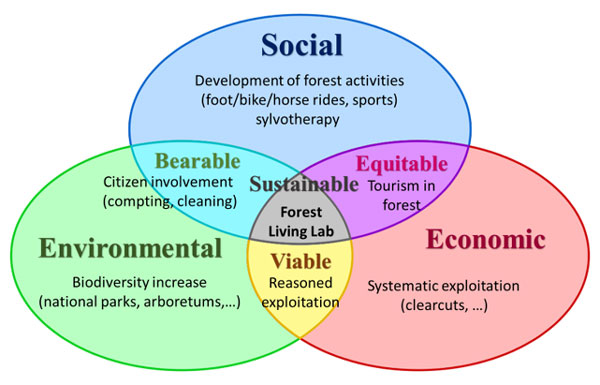by Christophe Ponsard and Bérengère Nihoul (CETIC)
Humans and forests share a longstanding common history, largely driven, from the human side, by economics. The consequence is ever-increasing degradation, despite progress in forest science and public awareness. We took a “living lab” approach to support the evolution of the Greater Luxembourg forest. The aim was to restore a more sustainable balance across various forest functions, in part by adopting a multiple-use management approach.
Forests are a key resource for humanity, but in many areas they are under increasing stress and degradation through deforestation, over-exploitation, and abandonment. These problems have existed for a long time [1], but they are still worsening, exacerbated by climate change-related events, such as increased frequency of fires and storms and the spread of pathogens.
The recent increase in public concern about the environment is a catalyst to rethink our relationship with the forest, using a cross-disciplinary approach involving not only professionals but also citizens, state organisations and research institutions. Co-innovative methods and digital tools for such user-centred creative processes have recently been developed, e.g., coworking, incubators, creative hubs, fab labs and living labs. The living lab is characterised by an open-innovation ecosystem, generally focused on a specific domain; in our case forestry. It integrates concurrent research and innovation processes within a public-private-partnership. It also provides an experiential environment where selected users are immersed to design and experience their own future [2].
Our living lab is anchored in the Greater Luxembourg forest, covering 2,375,000 ha across four countries (Luxembourg, Belgium, France and Germany). A large portion (over 40%) of this forest is privately owned and poorly maintained, thus returning to a wild state with positive (biodiversity) and negative impacts (spread of illness, fire risk). Biodiversity is also affected by monocultures of non-endemic species like spruce which dominate parts of the forest. To tackle these challenges, the living lab has explored all the dimensions of sustainability, i.e., environmental, social and economic, with various stakeholders and through two complementary projects: Agreta (focusing on tourism) [L1] and RegioWoodII (focusing on forest monitoring and management) [L2]. Key scenarios and activities illustrating those dimensions are depicted in Figure 1.

Figure 1: Different means for a sustainable forest.
A key point is to avoid restricting an area to single use relating to the goal of a specific stakeholder, but to keep it open to multi-objective/use/purposes, e.g., wood production, water quality, wildlife, recreation, aesthetics and clean air [L3]. Such a multi-use approach is not new but was deployed through a living lab based on the combined methodological experience of two Walloon research centres respectively specialised in information technology and forestry. The strengths and differentiators of our approach are:
- Workshopping activities to bring together people of different backgrounds and identify mutually enriching usage scenarios.
- Multi-objective identification and reasoning using different techniques such as system thinking. This approach can help to pinpoint synergies and barriers, or positive and negative feedback loops, relating to different stakeholders’ goals.
- Rapid technical feedback about existing tooling and related constraints, key issues and success factors (e.g., monitoring tools, tracking tools, information channels).
- Easy set-up of experiments involving different types of participant in specific or mixed scenarios.
As an example, participative workshops and online tools supporting collaborative decision making can help to work out how the combined monitoring and recreative functions of the forest might work together. From a technical perspective, useful information is provided by a variety of GIS tools such as WalOnMap [L4]. This helps us assess the potential for a given area to evolve towards more integrated and multiuse management by combining biodiversity, remarkable features (e.g., landscapes, rocks, waterways) and the path/road infrastructure. This approach is proving quite successful and is being applied by CETIC to other ecosystems, such as mobility management to organise ride sharing [3].
Links:
[L1] http://interreg.visitardenne.com/index.php/fr/agreta
[L2] http://www.regiowood2.info/en
[L3] https://www.thoughtco.com/multiple-use-1341734
[L4] https://geoportail.wallonie.be/walonmap
References:
[1] O. Ciancio, S. Nocentini: “The forest and man: The evolution of forestry thought from modern humanism to the culture of complexity”, Acad. Ital. Science Forestali, 1997.
[2] A. Kusiak: “Innovation: The Living Laboratory Perspective”, CAD & Applications, vol. 4, n°6, 2007.
[3] C. Ponsard: “Building sustainable software for sustainable systems: case study of a shared pick-up and delivery service”, GREENS@ICSE 2018.
Please contact:
Christophe Ponsard, CETIC, Belgium











